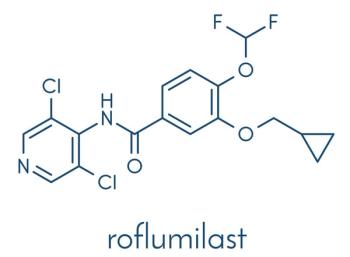
Are These Hyperpigmented Lesions Cause for Concern?
A 26-year-old white male aviator presents to his primary care physician for his annual military physical examination. The patient is healthy, takes no medications, and has no history of serious medical disorders. Genital examination reveals multifocal, confluent, slightly variegated, hyperpigmented macules with irregular borders located in a circumferential distribution on the penile shaft and glans.
A 26-year-old white male aviator presents to his primary care physician for his annual military physical examination. The patient is healthy, takes no medications, and has no history of serious medical disorders.
Genital examination reveals multifocal, confluent, slightly variegated, hyperpigmented macules with irregular borders located in a circumferential distribution on the penile shaft and glans. There is no associated surface elevation, erythema, or ulceration. Findings from the remainder of the cutaneous and mucous membrane examinations are unremarkable.
The patient reports that the macules have been present for more than 10 years; have never changed in shape, color, or size; and are not pruritic or painful. He has no history of sexually transmitted diseases, and he denies previous topical medication use or trauma in the area. The patient has no personal or family history of melanoma.
Would you offer reassurance-or biopsy?
Answer: Benign penile melanotic macules
On the basis of the clinical appearance of the lesions and the patient’s history, a diagnosis of benign penile melanotic macules was made. The decision was made to monitor clinically and not to biopsy at that time. The patient was told to return if he noted any changes in the size, shape, or color of the lesions.
Figure – These slightly variegated hyperpigmented lesions with irregular borders on the penile shaft (A) and glans (B) are benign genital melanotic macules.
Genital melanotic macules are fairly uncommon; an incidence of about 1 in 10,000 was reported in one series.1 Although the principal diagnostic concern for the clinician is cutaneous melanoma, the differential also includes benign entities with which a working familiarity is important.2 Genital melanotic macules present clinically with multifocal irregular brown pigmentation and irregular margins and are up to 2 cm in diameter.3-5 Simple lentigines appear with sharply circumscribed homogeneous or variegated brown to black pigmentation.6
Either of these benign lesions may occur spontaneously in adults in isolation or as part of a syndromic disorder such as Peutz-Jeghers syndrome (in association with hamartomatous intestinal polyps), Ruvalcaba-Myhre syndrome (with macrocephaly, mental deficiency, intestinal polyps, and angiolipomas), and LEOPARD syndrome (cardiac defects, short stature, and cephalofacial dysmorphism).1,6 Lentigines may also present as a component of a myxoma syndrome (LAMB syndrome, NAME syndrome, or Carney syndrome).1,6
On histological examination, benign lesions demonstrate basal layer hyperpigmentation and lack cellular atypia and nesting of melanocytes. Immunohistochemical staining for HMB45 antibody is negative. As with hyperpigmented lesions elsewhere on the body, the Glasgow 7-point checklist (change in size, change in shape, change in color, diameter of 7 mm or larger, inflammation, oozing or bleeding, and sensation change) can aid in the clinical suspicion of malignancy and may help guide the clinician toward biopsy, excision, or clinical monitoring.5
References:
REFERENCES:1. Lenane P, Keane CO, Connell BO, et al. Genital melanotic macules: clinical, histologic, immunohistochemical, and ultrastructural features. J Am Acad Dermatol. 2000;42:640-644.
2. Revuz J, Clerici T. Penile melanosis. J Am Acad Dermatol. 1989;20:567-570.
3. Barnhill RL, Albert LS, Shama SK, et al. Genital lentiginosis: a clinical and histopathologic study. J Am Acad Dermatol. 1990;22:453-460.
4. Laguna C, Pitarch G, Roche E, Fortea JM. Atypical pigmented penile macules [in Spanish]. Actas Dermosifiliogr. 2006;97:470-472.
5. de Giorgi V, Sestini S, Massi D, Lotti T. Melanocytic aggregation in the skin: diagnostic clues from lentigines to melanoma. Dermatol Clin. 2007;25:303-320, vii-viii.
6. Schwartz RA, Okulicz JF, Jozwiak S. Lentigo. http://emedicine.medscape. com/article/1068503. Accessed May 13, 2010.
Newsletter
Enhance your clinical practice with the Patient Care newsletter, offering the latest evidence-based guidelines, diagnostic insights, and treatment strategies for primary care physicians.




















































































































































































































































































